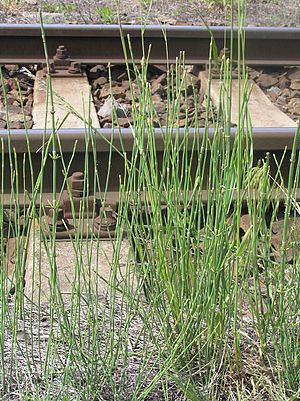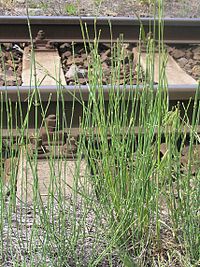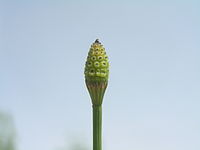Equisetum ramosissimum
Read community contributed articles on biodiversity & environment || Cultural practices & mythological stories related to Indian biodiversity || Official documents related to environment || NGOs, Blogs and Websites || Environment-related video collection || Plants of India || Mammals of India || Facebook || Twitter
Share this page: Equisetum ramosissimum
Click here to see all Semantic Properties associated with this page
Please note that the above slideshow is automatically created by searching Flickr and does not contain manually curated images. Hence, it is likely that some images may not be exactly of Equisetum ramosissimum.
Click on the tabs below to know more...
- Species identity and nomenclature
- Current Wikipedia entry
- Binomial Classification
- Morphological features
- Habitat and Geographical Spread
- Maps
- Medicinal Importance
- Cultural significance
- Commercial importance and cultivation
- Summary of PubMed articles
- Summary of NCBI molecular data
- External Links
- Images and Videos
| Parameter | Value(s) | References See complete references in the References section at the end |
|---|---|---|
| Names of users who have contributed to this species page | Gauravm | |
| Date on which this page was first created | 2010/05/21 | |
| This page was last modified on: | 23 November 2010 03:57:00 | |
| Name of the species | Equisetum ramosissimum | |
| ID on Encyclopedia of Life | 596759 | |
| Synonyms | Please check Binomial Classification section for synonyms. | |
| Common English Names | Branched Horsetail | |
| Common Hindi Names | ||
| Common Indian names | ||
| Origins/Meanings of the common names |
Taxonomy from Encyclopedia of Life
If nothing is displayed in this section, it means the EoL ID has not been defined. Please click on Edit with form button on top and follow the instructions for filling in the EoL ID
{{#EoLOnlyHierarchy:596759}}
Taxonomy filled in form

Click here for the PDF of the phylogeny
| Taxon | Value |
|---|---|
| Regnum (Kingdom) | Plantae |
| Division | Pteridophyta |
| Class | Equisetopsida |
| Order | Equisetales |
| Family | Equisetaceae |
| Genus | Equisetum |
| Source of data | ' |
| ||||||||||||||||||||
|
|
|
|
Based on classification
More details can be found in the Binomial Classification section.
Morphology from Encyclopedia of Life
If nothing is displayed in this section, it means the EoL ID has not been defined. Please click on Edit with form button on top and follow the instructions for filling in the EoL ID
{{#EoLOnlyDescription:596759}}
General morphology
| Parameter | Value(s) | References See complete references in the References section at the end |
|---|---|---|
| General morphological features of the plant | Cook |
| Seed dispersal mechanism | ||
|---|---|---|
| Bloom type | Cook | |
| Life cycle of the plant |
How to identify this species
For a detailed description, refer to the General Morphology details above
| Parameter | Value(s) | References See complete references in the References section at the end |
|---|---|---|
| Type of plant | ||
| Plant height | ||
| Flower color | Cook | |
| Flower shape | ||
| Floral symmetry | ||
| Phyllotaxy of leaves | ||
| Leaf shape | ||
| Is the leaf petiolated or sessile? | ||
| Is the leaf simple or compound? |
| Parameter | Value(s) | References See complete references in the References section at the end |
|---|---|---|
| IUCN Conservation Status | Not Evaluated | EoL |
| Indian States in which the species has been documented | Cook | |
| Locations at which the species has been documented | ||
| Biotic zones inhabited | ||
| Details about the habitat | It is a helophyte, an aquatic plant and grows in regularly flooded region. It is sometimes also found in shallow waters. It is often found dormant and can form extensive stands | Cook, Wiki |
| Is this species native to India? | No | Cook |
| Is the species indigenous/endemic to Sub-Himalayan regions? | No | Cook |
| Is the species indigenous/endemic to Western Ghats? | No | Cook |
| Is the species indigenous/endemic to Eastern Ghats? | No | Cook |
|
Plant is not native or native status not filled in |
If no maps are displayed below, it means the required data is absent. Click on "Edit with form" button on top of the page to add this information.
| Parameter | Value(s) | References See complete references in the References section at the end |
|---|---|---|
| Does this species have any medicinal use? | Yes |
|
Other plants of the same family having medicinal use:
|
| Parameter | Value(s) | References See complete references in the References section at the end |
|---|---|---|
| General types of ailments this species is used for treating | Infectious diseases, Accidents, Systemic disorders | |
| Specific ailments for which the species is used | Diabetes, Baldness, Bone fractures, Pneumonia, Gonorrhea, Hypertension, Eye swelling | Jain,Ethnoleaflets |
| Medicinal systems which use this plant | Ayurveda, Folk Medicine | |
| Details of Medicinal use | This plant has been used in India for several centuries as a medicine against skin wounds. Either the whole plant or the stem is used. Decoction of the whole plant and dried stems are believed to have liver-cleansing and diuretic properties. They are also believed to relieve hypertension, eye swelling and gonorrhea.
Among the islanders of the Indian Ocean, the whole plant is also used for diabetes,baldness, bone fracture and pneumonia. |
Jain,Ethnoleaflets |
| Parts of the plant used for treatment | ||
| Names of some medicinal active compounds in this plant, if known. | ||
| Details of the active chemical compounds found in this plant | ||
| Is the molecular basis of the medicinal action known? | No | |
| Details of molecular basis of action | ||
| Are the toxic effects of consumption of this plant known? | ||
| Details of the toxic effects of the plant species | ||
| Have there been validation/clinical studies related to this plant? | ||
| Details of the clinical studies related to the plant species |
| Parameter | Value(s) | References See complete references in the References section at the end |
|---|---|---|
| Is this plant/plant-derived product used in food preparations? | ||
| Part(s) of the plant used in the food preparations | ||
| Details of use in food preparations | ||
| Does this species have any religious significance? | ||
| Religions which mention/give significance to this species | ||
| Religious occasions | ||
| Details of religious use |
| Parameter | Value(s) | References See complete references in the References section at the end |
|---|---|---|
| Is this plant cultivated commercially in India? | ||
| Uses for which the plant is commercially cultivated | ||
| Plant parts of commercial value | ||
| Products where this plant is used | User-reported | |
| Description of use | ||
| States where this plant is cultivated commercially | ||
| Best period for planting this plant | ||
| Best period for harvesting this plant | ||
| Method of propagation | ||
| Water requirement of this plant | ||
| Pests and Diseases affecting this plant during cultivation | ||
| Other considerations while cultivating this plant |
Pubmed Word cloud
This word cloud is obtained using the tool LigerCat by searching the Pubmed database. LigerCat builds the cloud from the most relevant Medical Subject Headings (MeSH) terms. Each term's relative size indicates how many times it appears in the PubMed search results. Click on a term to access the full LigerCat cloud, with live PubMed search capabilities. LigerCat has been developed for the Biology of Aging Project.
The page may take some time to load since LigerCat is searching the entire PubMed database and sending us the results in real time.
- If there is an error message below, it means that there is no retrievable information available on NCBI
- If the number of nucleotide sequences is less than 100, very little genomic work has been done on this species. A respectable number of nucleotide sequences is above 10000.
- Most of the nucleotide sequences may come from three sources:
- Studies on single genes, where people try to sequence genes such as some specific dehydrogenases important,say, for tannin production
- Sequences of Ribosomal Internal Transcribed Spacer, whose sequence is used for generating molecular phylogenetic trees to establish species relationships
- Expressed Sequence Tags (ESTs) which can tell about which genes are present and expressed in the species at a particular time in the given tissue
{{#queryDB:taxonomy |Equisetum ramosissimum }}
| Parameter | Value(s) | References See complete references in the References section at the end |
|---|---|---|
| Details of modern scientific knowledge available for this species | E. ramosissimum is known to be toxic at high dosage. One study on horses indicates that Equisetum species have a high content of the enzyme thiaminase. Upon being eaten, the enzyme is released in the animal's gut and causes degradation of Vitamin B1 or thiamine. A high dose can lead to avitaminosis and death | Pohl |
| Are herbarium specimen available for this species? | ||
| Institutes having herbarium samples |
If nothing is displayed in this section, it means the EoL ID has not been defined. Please click on Edit with form button on top and follow the instructions for filling in the EoL ID
{{#EoLOnlyAdditionalInfo:596759}}
References
Jain (Journal) : Jain S.K. and Srivastava S. (Oct 2005),"Traditional uses of some Indian plants among islanders of the Indian Ocean, Indian Journal of Traditional Knowledge:4(4):345. doi=NA
Ethno (Journal) : Mannan M et al (2008),A Review on the Potential Uses of Ferns, Ethnobotanical Leaflets:12(1):281. doi=NA
Pohl (Journal) : Pohl R.W. (1955),Toxicity of Ferns and Equisetum, American Fern Journal:45(3):{{{page}}}. doi={{{doi}}}
Cook (Book) : Christopher D.K. Cook (1996),', ISBN: 019854821
Webentry (Web): Equisetum ramosissimum, Accessdate=2010-06-22



